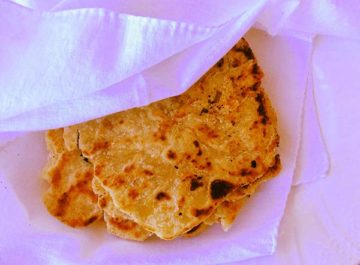
‘A Word on Food’ is done with … words … of course. Where would I be without them? Our blonde-haired, blue-eyed granddaughter Audrey is not yet two… yet she is teaching me to try more communication …
with the hand language known as ‘signing’. She has been taking lessons to learn how to say things with her hands.
We were gathering the other night for her Daddy’s birthday celebration in an Indian restaurant. The unmistakable aromas of curry dominated the small dining room. It was just after opening … and the place was already popping! Audrey was seated with her back to the wall near a corner between her happy parents when her Grandmother and I arrived. She locked her baby blues on me and instantly made the sign one makes in this clever, language for “Grandfather!”.
Over time the room grew loud with laughter … folks strained to be heard… a sizzling platter of some fragrant dish swept past us several times making quite a racket! For some … it was hard to get heard. Audrey … sagely made the sign … for ‘hungry’ …. and her father twisted off some naan bread and spread it with a mild chick pea mixture. Audrey smiled. Another universal form of dialog that worked in the din!
India holds over a billion people. It’s cuisines are encyclopedic. As one would expect … Indian cuisine varies wildly as one moves from region to region.
North Indian is agricultural despite the presence of the large cities of Delphi and Calcutta and has extreme climates – summers are hot and winters are cold. North Indian curries are usually thick, moderately spicy and creamy. Samosas, Chicken Tikka and Biryani are very popular there.
South Indian cuisine is perhaps the hottest of all Indian food. Meals are centered around rice to quell it some. Dosas … pancakes made from a batter of rice and lentil flour … are a favorite.
The Eastern region bears the strong influence of Chinese and Mongolian cuisine. Popular dishes there include Momos (meat or vegetable-filled wontons), Tomato Achaar (tomato pickle) and Jhaal-Muri (a spicy street prepared snack made with puffed rice and mustard oil).
Western India possibly has the most diverse styles of food in India. The climate is hotter and drier there so the relatively smaller variety of vegetables available are preserved as pickles and chutneys. Vindaloo is popular. Thaali … a large plate … is a style of eating there … A meal can consist of as many as 10 different vegetable dishes, rice and chapati … Indian bread.
Due to the various Indian diaspora communities … Fusion Cuisine has become an exciting field of taste exploration. Anglo-Indian, Indian-Singaporean, Malaysian-Indian are some. Another is Indian-Chinese. And as with many fusion cuisines this one was born out of historical upheaval. It originated in the 19th century among the Chinese neighborhoods within Calcutta … during a period of escape from the Opium Wars. After tasting Indian foods … the Chinese began to incorporate many spices and methods of cooking into the cuisine they had known for centuries. During the reign of the British in India, the cuisine was considered by the Europeans closely to what Gods taught of ambrosia. ‘Heaven on a plate’ in other words… I will ask my granddaughter what the sign for “ambrosia” is … when she gets a little older.
After the meal I was given the duty… and honor of helping her wash her expressive hands.
Now we could … ‘speak’… without curry … sticking to our sentences!
I’m Norman Van Aken and that’s…. My Word on Food